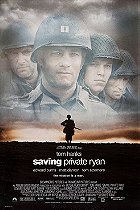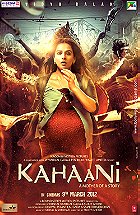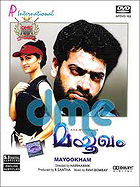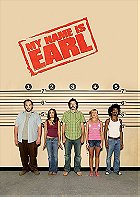Saving Private Ryan is a 1998 American war film set during the invasion of Normandy in World War II. It was directed by Steven Spielberg, with a screenplay by Robert Rodat. The film is notable for the intensity of its opening 27 minutes, which depicts the Omaha Beach assault of June 6, 1944. Afterwards, it follows Tom Hanks as U.S. Army Captain John H. Miller and seven men (Tom Sizemore, Edward Burns, Barry Pepper, Vin Diesel, Giovanni Ribisi, Adam Goldberg, and Jeremy Davies), as they search for a paratrooper, Private First Class James Francis Ryan (Matt Damon), who is the last surviving brother of four servicemen.
Rodat conceived the film's story in 1994 when he saw a monument dedicated to eight siblings killed in the American Civil War. Rodat imagined a similar sibling narrative set in World War II. The script was submitted to producer Mark Gordon, who handed it to Hanks. It was finally given to Spielberg, who decided to direct. The film's premise is loosely based on the real-life case of the Niland brothers.
Saving Private Ryan was well received by audiences and garnered considerable critical acclaim, winning several awards for film, cast, and crew as well as earning significant returns at the box office. The film grossed US$481.8 million worldwide, making it the highest-grossing domestic film of the year. The Academy of Motion Picture Arts and Sciences nominated the film for eleven Academy Awards; Spielberg's direction won him a second Academy Award for Best Director. Saving Private Ryan was released on home video in May 1999, earning $44 million from sales.
The film opens as an elderly World War II veteran and his family visit the Normandy American Cemetery and Memorial at Colleville-sur-mer; Normandy, France. The scene cuts to the morning of June 6, 1944, the beginning of the Normandy invasion, as American soldiers prepare to land on Omaha Beach. They struggle against dug-in German infantry, machine gun nests, and artillery fire, which cut down many of the men. Captain John H. Miller, the company commander of Charlie Company, 2nd Ranger Battalion, survives the initial landing and assembles a group of soldiers to penetrate the German defenses, leading to a breakout from the beach.
The scene then shifts to the United States where General George Marshall is informed that three of four brothers in the Ryan family have all died within days of each other and that their mother will receive all three notices on the same day. He learns that the fourth son, Private First Class James Francis Ryan of Baker Company, 506th Parachute Infantry Regiment, 101st Airborne Division is missing in action somewhere in Normandy. After reading to his staff Abraham Lincoln's letter to Mrs. Bixby, Marshall orders that Ryan be found and sent home immediately because of the Sole Survivor Policy.
Back in France, three days after D-Day, Miller receives orders to find Ryan. He assembles six men from his company (Horvath, Mellish, Reiben, Jackson, Wade, and Caparzo), plus one detailed from the 29th Infantry Division (Upham), a clerk who speaks fluent French and German, to accomplish the task. With no information about Ryan's whereabouts, Miller and his men move out to Neuville. On the outskirts of Neuville they meet a platoon from the 101st. After entering the town, Caparzo is wounded by a sniper in the chest, and slowly bleeds to death, since nobody can go out into the open without getting hit. Jackson is able to kill the sniper after Caparzo dies. They locate a Private James Frederick Ryan from Minnesota, but soon realize that he's not their man. They find a member of Charlie Company, 506th, who informs them that his drop zone was at Vierville and that Baker and Charlie companies had the same rally point. Once they reach it, Miller locates a friend of Ryan's, who reveals that Ryan is defending a strategically important bridge over the Merderet River in the town of Ramelle.
On the way to Ramelle, Miller decides to take the opportunity to neutralize a small German machine gun position close to an abandoned radar station, despite the misgivings of his men. Wade, their medic, is fatally wounded in the ensuing skirmish. The last surviving German, known only as "Steamboat Willie", incurs the wrath of all the squad members except Upham, who protests to Miller about letting the squad shoot the German soldier. The German pleads for his life and Miller decides to let him walk away, blindfolded, and surrender himself to the next Allied patrol. Viewing Miller's decision as letting the enemy go free, and no longer confident in Miller's leadership, Reiben declares his intention to desert the squad and the mission, prompting a confrontation with Horvath. The argument heats up, until Miller defuses the situation by revealing his pre-war occupation as an English teacher, a question upon which the squad had set up a betting pool. Reiben then reluctantly decides to stay.
The squad finally arrives on the outskirts of Ramelle, where they come upon three paratroopers ambushing a German half-track. Among the paratroopers is Ryan. After entering Ramelle, Ryan is told of his brothers' deaths, and their mission to bring him home, and that two lives had been lost in the quest to find him. He is distressed at the loss of his brothers, but does not feel it is fair to go home, asking Miller to tell his mother "when you found me I was here, and I was with the only brothers I have left," looking at the small band whose duty it was to defend a bridge and destroy an approaching German mechanized unit. Miller decides to take command and defend the bridge with what little manpower and resources are available.
The Germans arrive in force with more than 50 men supported by armor. In spite of inflicting heavy German casualties and even destroying two tanks with stiky bombs, most of the men—including Jackson, Mellish, and Horvath—are killed. While attempting to blow the bridge, Miller is shot and mortally wounded. Just before a Tiger I reaches the bridge, an American P-51 Mustang flies over and destroys it, followed by more Mustangs and advancing American infantry and M4 Sherman tanks who rout the remaining Germans. Upham, who was cut off from the Americans and hid in a ditch positioned next to German soldiers, executes "Steamboat Willie" upon finding him with a group of surrendering Germans and after witnessing him being the one who shot Miller. Ryan, Reiben, and Upham are the only survivors of the battle. Ryan is with Miller as he dies and says his last words, "James... earn this. Earn it."
Back in the present, the elderly veteran is revealed to be Ryan at Miller's grave. He asks his wife to confirm that he has led a good life and that he is a "good man" and thus worthy of the sacrifice of Miller and the others. He then salutes Miller's grave as the camera pans down the gravestones to a placid American flag.
In 1994, Robert Rodat saw a monument in Putney Corners, New Hampshire, memorializing those who had died fighting from the Civil War to Vietnam. He noticed the names of eight siblings who died during the American Civil War. Inspired by the story, Rodat did some research and decided to write a similar story set in World War II. Rodat's script was submitted to producer Mark Gordon, who liked the story but only accepted the text after 11 redrafts. Gordon shared the finished script with Hanks, who liked it and in turn passed it along to Spielberg to direct. A shooting date was set for June 27, 1997. Before filming began, several of the film's stars, including Edward Burns, Barry Pepper, Vin Diesel, Adam Goldberg, Giovanni Ribisi, and Tom Hanks, endured ten days of "boot camp" training and work on the film set to prepare for their roles. Matt Damon was not brought into the camp intentionally, to make the rest of the group feel resentment towards the character.
Spielberg had already demonstrated his interest in World War II themes with the films 1941, Empire of the Sun, Schindler's List, and the Indiana Jones series. Spielberg later co-produced the World War II themed television miniseries Band of Brothers and its counterpart The Pacific with Tom Hanks. When asked about this by American Cinematographer, Spielberg said, "I think that World War II is the most significant event of the last 100 years; the fate of the Baby Boomers and even Generation X was linked to the outcome. Beyond that, I've just always been interested in World War II. My earliest films, which I made when I was about 14 years old, were combat pictures that were set both on the ground and in the air. For years now, I've been looking for the right World War II story to shoot, and when Robert Rodat wrote Saving Private Ryan, I found it."
The D-Day scenes were shot in Ballinesker Beach, Curracloe Strand, Ballinesker, just east of Curracloe, Wexford, Ireland. Filming began June 27, 1997, and lasted for two months. Some shooting was done in Normandy, for the Normandy American Cemetery and Memorial in Colleville-sur-Mer and Calvados. Other scenes were filmed in English locations such as a former British Aerospace factory in Hatfield, Hertfordshire, London, Thame Park, Oxfordshire, and Wiltshire. Production was due to also take place in Seaham, County Durham, but government restrictions disallowed this.
Saving Private Ryan has been critically noted for its realistic portrayal of World War II combat. In particular, the sequence depicting the Omaha landings was voted the "best battle scene of all time" by Empire magazine and was ranked number one on TV Guide's list of the "50 Greatest Movie Moments".[13] The scene cost US$12 million and involved up to 1,500 extras, some of whom were members of the Irish Reserve Defence Forces. Members of local reenactment groups such as the Second Battle Group were cast as extras to play German soldiers.[14] In addition, twenty to thirty actual amputees were used to portray US soldiers maimed during the landing.[15] Spielberg did not storyboard the sequence, as he wanted spontaneous reactions and for "the action to inspire me as to where to put the camera".[16]
The historical representation of Charlie Company's actions, led by its commander, Captain Ralph E. Goranson, was well maintained in the opening sequence. The sequence and details of the events are very close to the historical record, including the seasickness experienced by many of the soldiers as the landing craft moved toward the shoreline, significant casualties among the men as they disembarked from the boats, and difficulty linking up with adjacent units on the shore. The contextual details of the Company's actions were well maintained, for instance, the correct code names for the sector Charlie Company assaulted, and adjacent sectors were used. Included in the cinematic depiction of the landing was a follow on mission of clearing a bunker and trench system at the top of the cliffs which was not part of the original mission objectives for Charlie Company, but which they did undertake after climbing the cliffs at Pointe du Hoc.[17]
The landing craft used included twelve actual World War II examples, 10 LCVPs and 2 LCMs, standing in for the British LCAs that the Ranger Companies rode in to the beach during Operation Overlord.[17][18] The film-makers used underwater cameras to better depict soldiers being hit by bullets in the water. Forty barrels of fake blood were used to simulate the effect of blood in the seawater.[15] This degree of realism was more difficult to achieve when depicting World War II German armored vehicles, as few examples survive in operating condition. The Tiger I tanks in the film were copies built on the chassis of old, but functional Soviet T-34 tanks. The two vehicles described in the film as Panzers were meant to portray Marder III tank destroyers. One was created for the film using the chassis of a Czech-built Panzer 38(t) tank similar to the construction of the original Marder III; the other was a cosmetically modified Swedish SAV m/43 assault gun, which also used the 38(t) chassis.
Inevitably, some artistic license was taken by the filmmakers for the sake of drama. One of the most notable is the depiction of the 2nd SS Panzer Division Das Reich, as the adversary during the fictional Battle of Ramelle. The 2nd SS was not engaged in Normandy until July, and then at Caen against the British and Canadians, one hundred miles east. Furthermore, the Merderet River bridges were not an objective of the 101st Airborne Division but of the 82nd Airborne Division, part of Mission Boston. Much has been said about various "tactical errors" made by both the German and American forces in the film's climactic battle. Spielberg responded, saying that in many scenes he opted to replace sound military tactics and strict historical accuracy for dramatic effect.
To achieve a tone and quality that was true to the story as well as reflected the period in which it is set, Spielberg once again collaborated with cinematographer Janusz Kamiński, saying, "Early on, we both knew that we did not want this to look like a Technicolor extravaganza about World War II, but more like color newsreel footage from the 1940s, which is very desaturated and low-tech." Kamiński had the protective coating stripped from the camera lenses, making them closer to those used in the 1940s. He explains that "without the protective coating, the light goes in and starts bouncing around, which makes it slightly more diffused and a bit softer without being out of focus." The cinematographer completed the overall effect by putting the negative through bleach bypass, a process that reduces brightness and color saturation. The shutter timing was set to 90 or 45 degrees for many of the battle sequences, as opposed to the standard of 180 degree timing. Kamiński clarifies, "In this way, we attained a certain staccato in the actors' movements and a certain crispness in the explosions, which makes them slightly more realistic."
The film was distributed by DreamWorks in North America and by Paramount Pictures internationally. As a result of Paramount's 2005 acquisition of DreamWorks, Paramount has gained North America distribution rights as well (though still through the DreamWorks division). Saving Private Ryan was a critical and commercial success and is credited with contributing to a resurgence in America's interest in World War II. Old and new films, video games, and novels about the war enjoyed renewed popularity after its release. The film's use of desaturated colors, hand-held cameras, and tight angles has profoundly influenced subsequent films and video games. Saving Private Ryan was released in 2,463 theatres on July 28, 1998, and grossed $30.5 million on its opening weekend. The film grossed $216.5 million in North America and $265.3 million on other territories, bringing its worldwide total to $481.8 million and making it the highest grossing domestic film of the year.
Critical reception for the film was generally positive, with much praise for the realistic battle scenes[29] and the actors' performances,[30] but earning some criticism for the script and for ignoring the contributions of several other countries to the D-Day landings in general and at Omaha Beach specifically.[31] The most direct example of the latter is that during the actual landing the 2nd Rangers disembarked from British ships and were taken to Omaha Beach by Royal Navy landing craft (LCAs). The film depicts them as being United States Coast Guard-crewed craft (LCVPs and LCMs) from an American ship, the USS Thomas Jefferson (APA-30).[17][32][33] This criticism was far from universal with other critics recognizing the director's intent to make an "American" film.[34] The film was not released in Malaysia after Spielberg refused to cut the violent scenes;[35] however, the film was finally released there on DVD with an 18SG certificate much later in 2005. It currently scores 91% "Certified Fresh" on Rotten Tomatoes[36] and 90% on Metacritic,[37] two film review aggregate sites. Many critics associations, such as New York Critics Circle and Los Angeles Film Critics Association, chose Saving Private Ryan as Film of the Year.[38] Roger Ebert gave it four stars out of four and called it "a powerful experience".[30]
Filmmaker Quentin Tarantino has expressed admiration for the film and has cited it as an influence on his 2009 war epic, Inglourious Basterds.[39] In an interview, Tarantino told interviewer Samuel Blumenfeld, "Spielberg is doing something unheard of with the opening of this movie. When you watch the sequence of the landing, it’s no longer possible to look the same way at The Longest Day, or even Samuel Fuller's The Big Red One... Saving Private Ryan made me aware of some issues raised by the cinema of war that I was unable to ask on my own. The idea that forty men on a boat are exterminated in seconds by a volley of machine gun fire is terrifying. Can you imagine the most atrocious carnage? Obviously, yes. Except that throughout the scene, you are persuaded to attend the worst slaughter in history. The sequence of the knife fight between a U.S. soldier and a Nazi at the end of the film is also as notable as the landing. I hate war movies where they show a soldier killing his opponents without sweating, as if it were insignificant. If I was fighting to save my skin, I think it would be a little more difficult. It's hard to kill someone, it takes sweat, and even with this, you have no guarantee of reaching your goals. Spielberg managed admirably to stage this scene with that dimension."
The actor Richard Todd, who performed in The Longest Day and was amongst the first of the Allied soldiers to land in Normandy, said the film was "Rubbish. Overdone." Other WWII veterans, however, stated that the film was the most realistic depiction of combat they had ever seen.The film was so realistic that combat veterans of D-Day and Vietnam left theaters rather than finish watching the opening scene depicting the Normandy invasion. Their visits to posttraumatic stress disorder counselors rose in number after the film's release, and many counselors advised "'more psychologically vulnerable'" veterans to avoid watching it.
The film was later nominated for eleven Academy Awards, with wins for Best Cinematography, Best Sound, Best Sound Effects Editing, Best Film Editing, and Best Director for Spielberg, but lost the Best Picture award to Shakespeare in Love, being one of a few that have won the Best Director award without also winning Best Picture. The film also won the Golden Globes for Best Picture – Drama and Director, the BAFTA Award for Special Effects and Sound, the Directors Guild of America Award, a Grammy Award for Best Film Soundtrack, the Producers Guild of America Golden Laurel Award, and the Saturn Award for Best Action/Adventure/Thriller Film. In June 2008, the American Film Institute revealed its "Ten Top Ten"—the best ten films in ten "classic" American film genres—after polling over 1,500 people from the creative community. Saving Private Ryan was listed as the eighth best film in the "epic films" genre.
Saving Private Ryan review
 Posted : 13 years, 6 months ago on 17 December 2011 12:47
(A review of Saving Private Ryan)
Posted : 13 years, 6 months ago on 17 December 2011 12:47
(A review of Saving Private Ryan) 0 comments, Reply to this entry
0 comments, Reply to this entry
Jo Hum Chahein review
 Posted : 13 years, 6 months ago on 13 December 2011 04:19
(A review of Jo Hum Chahein)
Posted : 13 years, 6 months ago on 13 December 2011 04:19
(A review of Jo Hum Chahein)This is a coming of age story of Rohan Bhatia and Neha Kapoor, two young, hip, effervescent individuals whose lives change forever once they meet and fall in love. Rohan is a brash, cocky, ambitious, 24 year old MBA graduate who wants instant success and he'll do anything to make that come true! Rohan moves to Mumbai to pursue a career as a stockbroker where he meets Neha, a no nonsense, strong headed girl who's come to Mumbai to follow her dreams, the dream of becoming a film actor. Neha is someone who believes in love, but hasn't given and guy a chance because no one measures up to her standards of Mr. Right. That's until Rohan comes along and her life changes completely. Both of them have different wants, desires and quests but they manage to come together and go on a journey that intertwines their personal and professional lives where they touch the peaks of love, loss, despair, longing, betrayal and redemption.
 0 comments, Reply to this entry
0 comments, Reply to this entry
Kahaani review
 Posted : 13 years, 6 months ago on 6 December 2011 11:06
(A review of Kahaani)
Posted : 13 years, 6 months ago on 6 December 2011 11:06
(A review of Kahaani)Kahaani is an upcoming 2012 Bollywood thriller film directed and co-produced by Sujoy Ghosh and starring Vidya Balan and Emraan Hashmi in the lead roles. The movie is expected to release on March 9, 2012.
A desperate, heartwrenching and suspenseful tale of a pregnant woman, in search of her missing husband.
Cast: Vidya Balan, emraan hashmi
Director: Sujoy Ghosh
Producer: Sujoy Ghosh
Music Director: Vishal & Shekhar
Release Date: Friday, January 20, 2012
A desperate, heartwrenching and suspenseful tale of a pregnant woman, in search of her missing husband.
Cast: Vidya Balan, emraan hashmi
Director: Sujoy Ghosh
Producer: Sujoy Ghosh
Music Director: Vishal & Shekhar
Release Date: Friday, January 20, 2012
 0 comments, Reply to this entry
0 comments, Reply to this entry
Mayookham review
 Posted : 13 years, 7 months ago on 30 November 2011 03:50
(A review of Mayookham)
Posted : 13 years, 7 months ago on 30 November 2011 03:50
(A review of Mayookham)Mayookham (2005) is a Malayalam film starring Saiju Kurup and Mamta Mohandas in the lead. The film was directed by Hariharan.
Unni Kesavan (Saiju) and Indira (Mamta) are childhood friends. Indira goes to US with her father (Saikumar), a doctor and comes back after many years to their family house. She meets Unni and is shocked to see him as a rebel. She tries to help him by supporting and giving him a new lease of life and slowly love blossoms between the two. Indira become the light in Unni’s life and she motivates him to turn responsible. But fate plays dirty as Indira is terminally ill and she goes back for treatment.
The film is a musical entertainment and says more. Music director of this film is Ravi Bombay.
The film has several similarities with the hollywood film A Walk to Remember.
Unni Kesavan (Saiju) and Indira (Mamta) are childhood friends. Indira goes to US with her father (Saikumar), a doctor and comes back after many years to their family house. She meets Unni and is shocked to see him as a rebel. She tries to help him by supporting and giving him a new lease of life and slowly love blossoms between the two. Indira become the light in Unni’s life and she motivates him to turn responsible. But fate plays dirty as Indira is terminally ill and she goes back for treatment.
The film is a musical entertainment and says more. Music director of this film is Ravi Bombay.
The film has several similarities with the hollywood film A Walk to Remember.
 0 comments, Reply to this entry
0 comments, Reply to this entry
Kadha Thudarunnu review
 Posted : 13 years, 7 months ago on 30 November 2011 03:46
(A review of Kadha Thudarunnu)
Posted : 13 years, 7 months ago on 30 November 2011 03:46
(A review of Kadha Thudarunnu)Kadha Thudarunnu (Malayalam: കഥ തുടരുന്നു; English: The Story Continues) is a 2010 Malayalam film written and directed by Sathyan Anthikkad. The lead pair in the film are Mamta Mohandas and Jayaram. It was the 50th film of Sathyan Anthikkad's career as a director.This movie is an alleged copycat of 2006 American biographical drama film The Pursuit of Happyness.
Vidyalakshmi Nambiar (Mamta Mohandas), scion of a rich upper caste aristrocratic family gets married to Shanavas (Asif Ali), a Muslim, against the diktats of both the families. Though, happily married, life is not a smooth ride for them. Few years passed by and the couple now has a daughter Laya, who is now in nursery. Despite strong financial troubles, Shanavas does his best to take care of his family. One rainy night, on his way to purchase mangoes for his daughter, Shanavas is killed by a group of goon, mistaking him to be someone else. Having nowhere to go, Vidyalakshmi is trying her best to take care of her daughter. But, the financial troubles forces her to cut down the daily expenses, including the school bus for her daughter. Within short time, she is asked to vacate the house, as there has been a long delay in payment of rent. Vidyalakshmi, with nowhere to go, decides to sleep on railway platform with her daughter. One fine morning, she catches an auto to drop her kid at school. Preman (Jayaram), the auto driver is a talkative and simple chap, with a sense of humor. But after travelling, she gets out of the auto and escapes without paying the cash. The next day, Preman finds her at railway station, and on demanding the auto fare, she explains her story to him, which makes him feel sympathetic to her. He brings Vidyalakshmi and her daughter to his colony. Vidyalakshmi, within short time captures the hearts of the people around. When Preman comes to know that she was doing her MBBS when got married and had to give up studies after that, he makes her to appear of final year exam. With the support of the colony residents, Vidyalakshmi appears of MBBS examination and becomes a doctor. Her daughter, one day comes in contact with the mother of Shanavas, who wants now her grand daughter to b brought to home. But Vidyalakshmi politely refuses it. The elder brother of Shanavas threatens her with the support of a Moulavi, but Preman intervenes and force them to go back. With the help of her friend, Vidhyalakkshmi gets a job in Kuwait and though not willing, she had to accept it. She leaves to Kuwait with her daughter, promising to come back soon. Preman is seen waiting at beach, looking for the next news from Vidyalakshmi.
Vidyalakshmi Nambiar (Mamta Mohandas), scion of a rich upper caste aristrocratic family gets married to Shanavas (Asif Ali), a Muslim, against the diktats of both the families. Though, happily married, life is not a smooth ride for them. Few years passed by and the couple now has a daughter Laya, who is now in nursery. Despite strong financial troubles, Shanavas does his best to take care of his family. One rainy night, on his way to purchase mangoes for his daughter, Shanavas is killed by a group of goon, mistaking him to be someone else. Having nowhere to go, Vidyalakshmi is trying her best to take care of her daughter. But, the financial troubles forces her to cut down the daily expenses, including the school bus for her daughter. Within short time, she is asked to vacate the house, as there has been a long delay in payment of rent. Vidyalakshmi, with nowhere to go, decides to sleep on railway platform with her daughter. One fine morning, she catches an auto to drop her kid at school. Preman (Jayaram), the auto driver is a talkative and simple chap, with a sense of humor. But after travelling, she gets out of the auto and escapes without paying the cash. The next day, Preman finds her at railway station, and on demanding the auto fare, she explains her story to him, which makes him feel sympathetic to her. He brings Vidyalakshmi and her daughter to his colony. Vidyalakshmi, within short time captures the hearts of the people around. When Preman comes to know that she was doing her MBBS when got married and had to give up studies after that, he makes her to appear of final year exam. With the support of the colony residents, Vidyalakshmi appears of MBBS examination and becomes a doctor. Her daughter, one day comes in contact with the mother of Shanavas, who wants now her grand daughter to b brought to home. But Vidyalakshmi politely refuses it. The elder brother of Shanavas threatens her with the support of a Moulavi, but Preman intervenes and force them to go back. With the help of her friend, Vidhyalakkshmi gets a job in Kuwait and though not willing, she had to accept it. She leaves to Kuwait with her daughter, promising to come back soon. Preman is seen waiting at beach, looking for the next news from Vidyalakshmi.
 0 comments, Reply to this entry
0 comments, Reply to this entry
Yamadonga review
 Posted : 13 years, 7 months ago on 30 November 2011 03:41
(A review of Yamadonga)
Posted : 13 years, 7 months ago on 30 November 2011 03:41
(A review of Yamadonga)Raja(Jr. NTR), an orphan, is a ruthless robber. He dreams of earning a fast buck so that he can settle down in life. And then, he stumbles on a fine opportunity. A ravishing beauty Mahi (Priyamani), a rich heiress, falls in love with him. The girl happens to be his childhood well-wisher and has always considered him her prince.
He plans to surrender the girl to a gang who wants to kill her for her riches. But the villains play foul, and kill him. Raja reaches Yamaloka. He creates confusion in Yamaloka by stealing Yamapasam as whoever in possession of Yamapasam will become Yama. The rest of the story is all about how Yama (Mohan Babu) and Raja try to outsmart each other. After regaining power, Yama sends Raja back to earth, but only to take away his life once again.
He plans to surrender the girl to a gang who wants to kill her for her riches. But the villains play foul, and kill him. Raja reaches Yamaloka. He creates confusion in Yamaloka by stealing Yamapasam as whoever in possession of Yamapasam will become Yama. The rest of the story is all about how Yama (Mohan Babu) and Raja try to outsmart each other. After regaining power, Yama sends Raja back to earth, but only to take away his life once again.
 0 comments, Reply to this entry
0 comments, Reply to this entry
Good Neighbours review
 Posted : 13 years, 7 months ago on 20 November 2011 03:27
(A review of Good Neighbours)
Posted : 13 years, 7 months ago on 20 November 2011 03:27
(A review of Good Neighbours)Good Neighbors is a 2010 Canadian black comedy-drama/thriller film which was written and directed by Jacob Tierney. It is based on the book by Chrystine Brouillet.
The plot revolves around a trio of Anglophones who live in the same apartment building in Montreal's Notre-Dame-de-Grâce neighbourhood. There is a serial killer on the loose, and they attempt to discover who it is.
It stars Jay Baruchel, Scott Speedman and Emily Hampshire. Tierney filmed it under the working title "Notre Dame de Grâce" in and around Montreal, Quebec, Canada.
The film had its world premiere as part of the 2010 Toronto International Film Festival on 15 September 2010. Magnolia Pictures released it for the Whistler Film Festival.
The plot revolves around a trio of Anglophones who live in the same apartment building in Montreal's Notre-Dame-de-Grâce neighbourhood. There is a serial killer on the loose, and they attempt to discover who it is.
It stars Jay Baruchel, Scott Speedman and Emily Hampshire. Tierney filmed it under the working title "Notre Dame de Grâce" in and around Montreal, Quebec, Canada.
The film had its world premiere as part of the 2010 Toronto International Film Festival on 15 September 2010. Magnolia Pictures released it for the Whistler Film Festival.
 0 comments, Reply to this entry
0 comments, Reply to this entry
How I Met Your Mother review
 Posted : 14 years, 1 month ago on 1 June 2011 11:51
(A review of How I Met Your Mother)
Posted : 14 years, 1 month ago on 1 June 2011 11:51
(A review of How I Met Your Mother)well i have seen 6 seasons so far and realised how friends are about and the story is so awesome ...no need to describe to those who watched it ....but a little interconnection between seasons is marvelous..
 0 comments, Reply to this entry
0 comments, Reply to this entry
My Name Is Earl review
 Posted : 14 years, 1 month ago on 1 June 2011 11:47
(A review of My Name Is Earl)
Posted : 14 years, 1 month ago on 1 June 2011 11:47
(A review of My Name Is Earl)well when i watched this tv series i was surprised to have such a nice story since i hate connections between episodes...its better to hav each episode with differnt concepts or story....so imma ready to watch season 3 and 4...
 0 comments, Reply to this entry
0 comments, Reply to this entry
Bhagavad Gita: A New Translation review
 Posted : 14 years, 1 month ago on 8 May 2011 05:26
(A review of Bhagavad Gita: A New Translation)
Posted : 14 years, 1 month ago on 8 May 2011 05:26
(A review of Bhagavad Gita: A New Translation)well here it goes if u believe in doing things without caring for the outcome then u will be paid satisfactorily...but do the work with good intentions...
 0 comments, Reply to this entry
0 comments, Reply to this entry
 Login
Login
 Home
Home 47 Lists
47 Lists 28 Reviews
28 Reviews Collections
Collections